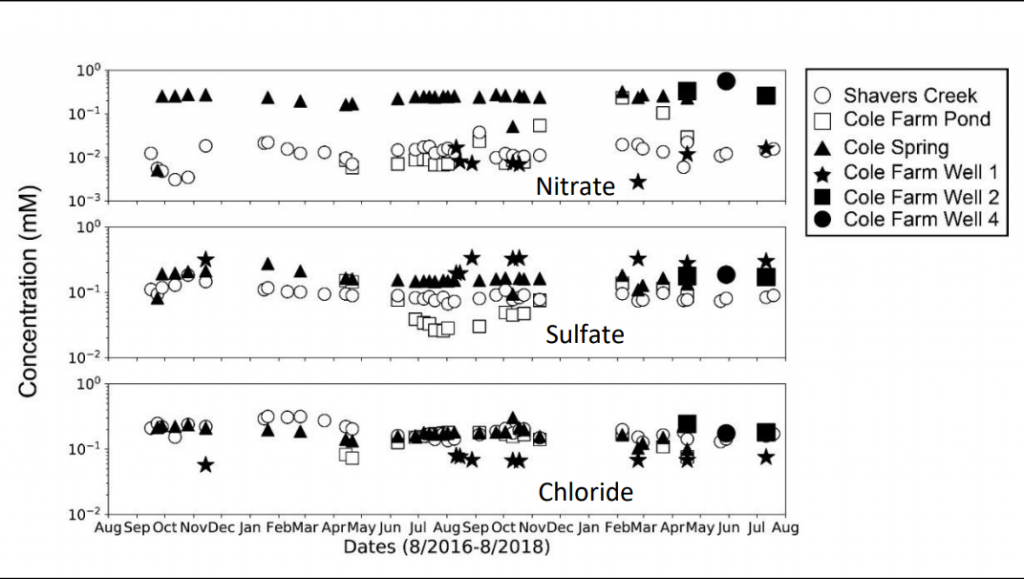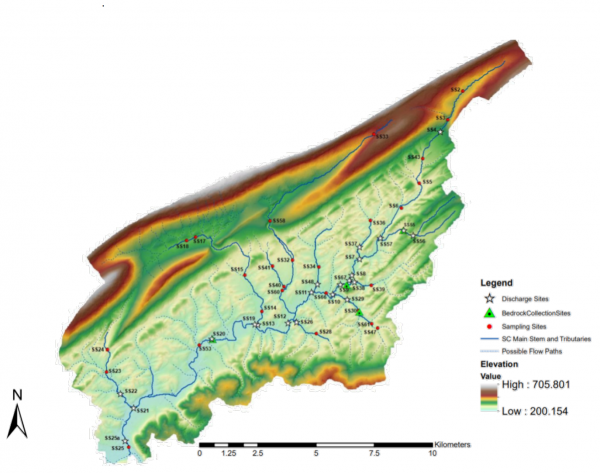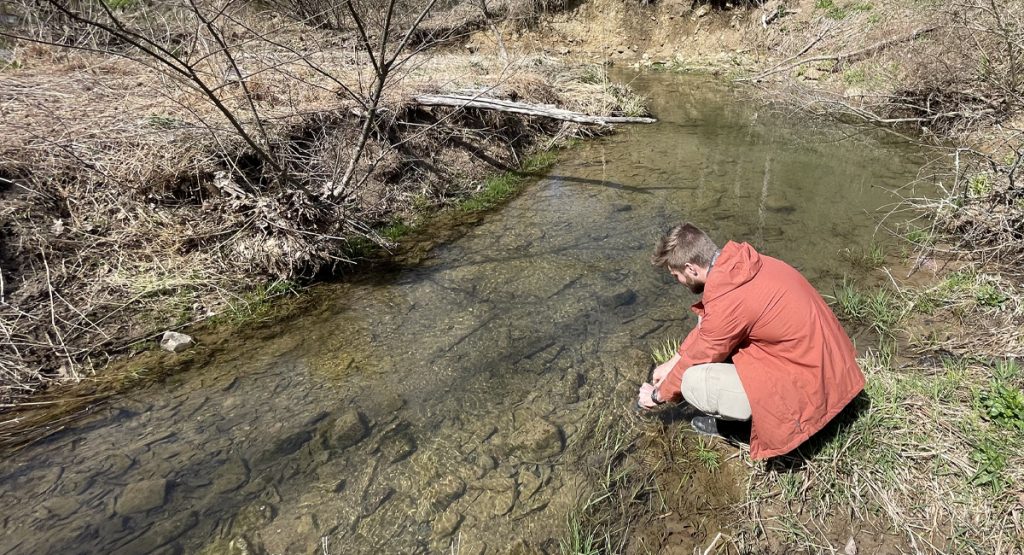For her capstone project, graduating environmental resource management student Bryn Wambaugh investigated the work being done in the Shaver’s Creek watershed by the Shale Hills Critical Zone Observatory. We are sharing a series of Bryn’s articles, written with the public in mind, to educate readers while illustrating the great research done at the Shale Hills CZO and supported by Shaver’s Creek.
Read the previous entries in Bryn’s series:
What Is Nutrient Pollution and What Are Its Impacts?
Riparian Buffers and Denitrification
What Is a Critical Zone and What Is the Susquehanna Shale Hills Critical Zone Observatory
Shale Hills and Garner Run
Cole Farm
Susquehanna Shale Hills Critical Zone Observatory (SSHCZO) is continuously researching the critical zone in Shaver’s Creek watershed. This research helps us to better understand the critical zone and how our land management practices may be impacting it. The findings at Cole Farm are the most pertinent to the land use of the area, but throughout the watershed there are also other interesting sites.
Findings
Cole Farm
Nitrate values do not significantly increase from Shaver’s Creek Above Lake (SCAL) (0.0029-0.0202mM) to Shaver’s Creek Cole Farm (SCCF) (0.0031-0.0374mM). Nitrate levels are consistently greater at Shaver’s Creek Outlet (SCO) (0.0230-0.0875mM) than sites above SCCF. This is not surprising as the percentage of agricultural land in the SCCF drainage area is ~5% while it is ~18% in the SCO drainage area (Wayman, 2018).
At Cole Farm, nitrate, sulfate, and chloride concentrations vary amongst the different sampling sites. Nitrate in the surface water at Cole Spring (CSp) is highest (0.23 mM ± 0.06, n = 30). Cole Farm Well 1 (CFW1) (0.01 mM ± 0.005, n = 9) and SCCF (0.013 mM ± 0.006, n = 38) have similar nitrate concentrations. Cole Farm Well 2 (CFW2) and Cole Farm Well 4 (CFW4) both (0.30 mM ± 0.04, n = 2 at CFW2 and 0.56 mM at CFW4) have greater nitrate concentrations than those observed at CSp. In contrast to nitrate concentrations, sulfate concentrations are highest at CFW1 (0.28 mM ± 0.05, n = 9).

Other Sampling Sites
There is a spike of nitrate concentrations at SS66. Since SCCF has relatively low levels of nitrate, this shows that the southeast branch with SS47, SS61, SS30, and SS29 are contributing higher* levels of nitrate to the stream. These higher levels of nitrate are from the higher population of cattle in that subcatchment. This supports the assumption that higher populations of cattle contribute to higher levels of nitrate (Osenbach, 2019).
*While higher than the nitrate levels at SCCF, these levels are still below the average rate of nitrate contamination in PA counties’ streams (EWG, 2017).

Putting it all Together
Cole Farm
The fields at Cole Farm represent a unique aspect of farms in Pennsylvania. The fields are steep and sloping inwards which causes higher levels of runoff. Despite this, the nitrate levels at Cole Farm are lower than the average contamination rate of nitrate in PA counties’ streams (EWG, 2017). This may be because of the farmer’s Best Management Practice (BMP), no-till farming (Osenbach, 2019). No-till farming saves farmers money on fuel for equipment, labor, and fertilizers (Creech, 2018). No-till locks nutrients in the soil and keeps them out of streams.
Other Sampling Sites
Although there is a spike of nutrients at Sampling Site 66 (SS66) caused by the high cattle population in the catchment to the southeast, it is worth noting that the spike is also below the average contamination rate of nitrate in PA counties’ streams (EWG, 2017). In many ways, it is hard to control the level of nutrients running off a cattle operation, but one way to lower levels of nitrate is by installing a Riparian Buffer or a filter strip. If you are interested in installing a Riparian Buffer at your farm, please look at the resources in the Riparian Buffers article of this series.

Shaver’s Creek Watershed
Overall, the farmers in Shaver’s Creek watershed manage their land well, and the nitrate levels at SCO are below average levels for streams in Pennsylvanian counties (EWG, 2017). Adopting additional BMPs like filter strips, cover cropping, riparian buffers, or the no-till farming practiced at Cole Farm will further lower the levels of nitrate in the watershed. Understanding how our land management affects the critical zone is an important service that the SSHCZO provides. Although there are no opportunities to get involved in SSHCZO Snapshot day this year, you can look forward to events like this in the future!
References
- Creech, E. (2018, January 25). Farmers keeping nutrients on the field, out of streams. Retrieved May 08, 2021, from https://www.usda.gov/media/blog/2017/12/13/farmers-keeping-nutrients-field-out-streams
- Ewg. (2017). Ewg investigation: Across farm country, nitrate pollution of drinking water for more than 20 million Americans is getting worse. Retrieved May 08, 2021, from https://www.ewg.org/interactive-maps/2020-nitrate-pollution-of-drinking-water-for-more-than-20-million-americans-is-getting-worse/pa/
- Forgeng, M.J. (2021). Investigating nitrate transport and denitrification in hilly terrain from the scale of a single farm field to a HUC-10 watershed. Unpublished.
- Osenbach, E. (2020). Sources of nitrates in the Shaver’s Creek Watershed in the Susquehanna River Basin [Unpublished Senior Thesis, The Pennsylvania State University]
- Wayman, C. R., & Brantley, S. L. (2018). Understanding the effects of hydrologic connectivity, land use, and lithology on land use across scales: from a zeroth order catchment to a HUC 10 watershed in the Susquehanna River Basin [Unpublished master’s thesis, The Pennsylvania State University]
